Faversham
Preston street
A Troop, Royal East Kent (The Duke of Connaught's Own) (Mounted Rifles)
Yeomanry (B Squadron [Faversham troop])
Kent Artillery (1st) Volunteer Brigade, Eastern division, Royal Artillery (3 & 4 Batteries
Home Counties (Kent) Royal Garrison Artillery Heavy Battery (left half)
The Faversham listing in Kelly's 1913 Directory of Kent tells us that 'the Territorial Force in the town comprises the A Troop of the Royal East Kent (The Duke of Connaught's Own) (Mounted Rifles) Yeomanry (B Squadron [Faversham troop]), Faversham being the headquarters of the Squadron.'
Kelly, 1891 lists 'Kent Artillery (1st) Volunteer Brigade, Eastern division, Royal Artillery (3 & 4 Batteries), Drill hall, Preston st.'
Kelly, 1913, records the 'Home Counties (Kent) Royal Garrison Artillery Heavy Battery (left half), Drill hall, Preston street.' It numbered 'about 80 men; the practice battery is at Harty Ferry*, and the drill hall and armoury together with the gun repository and drill room is in Preston street.'
Sadly, the exterior of the drill hall does not seem well cared for (2007), yet it is a building rich with features. A postcard from 1905 clearly shows its attractive rusticated quoins, its deeply moulded sills and its architraves. It is entered by a porch at the side. The drill hall has a presence and dignity within the street scene. Its inscription is just visible: it refers to Nos. 3 and 4 Companies, First Kent Artillery Volunteers, Eastern Division, R.A. [Royal Artillery]
A water colour painted by the architect, Martin Bulmer, in 1853, depicts a splendidly elegant assembly room with three magnificent octagonal lanterns, a balcony with a cast-iron balustrade above a set of panelled doors, all in rich, warm colours with what seem to be large paintings on the walls.
Arthur Percival, of the Faversham Society, has shared some interior photographs taken in 1980, showing, among other features, the ceiling plinth and elegant plaster brackets. We understand that little has changed since then.
Currently the drill hall is used by the ATC and Army Cadets. There is a caretaker's house which is used as class rooms and offices. Apparently there is also a gun shed, which is not in use.
It seems, in 2007, that the future of the building is uncertain; seen as a 'disposal' by the MoD, there is strong local support for its retention and reuse within the community. We wholeheartedly support this option.
*Note: Harty Ferry is north of Faversham, where the Visitor Centre of the Oare Marshes Nature Reserve is now. Until 1939 there was a pedestrian ferry across to the Isle of Harty, part of the Isle of Sheppey. Oare Marshes Nature Reserve occupies part of the site of what till 1918 was a huge high explosives factory.
A water colour painted by the architect, Martin Bulmer, in 1853, depicts a splendidly elegant asembly room with three magnificent octagonal lanterns, a balcony with a cast-iron balustrade above a set of panelled doors, all in rich, warm colours with what seem to be large paintings on the walls. View
We are very appreciative of all the help and insights generously given by Arthur Percival and the Faversham Society in compiling the information on this Drill Hall.
http://www.faversham.org/society
Articles published about Faversham Drill Hall
Yeomanry (B Squadron [Faversham troop])
Kent Artillery (1st) Volunteer Brigade, Eastern division, Royal Artillery (3 & 4 Batteries
Home Counties (Kent) Royal Garrison Artillery Heavy Battery (left half)
The Faversham listing in Kelly's 1913 Directory of Kent tells us that 'the Territorial Force in the town comprises the A Troop of the Royal East Kent (The Duke of Connaught's Own) (Mounted Rifles) Yeomanry (B Squadron [Faversham troop]), Faversham being the headquarters of the Squadron.'
Kelly, 1891 lists 'Kent Artillery (1st) Volunteer Brigade, Eastern division, Royal Artillery (3 & 4 Batteries), Drill hall, Preston st.'
Kelly, 1913, records the 'Home Counties (Kent) Royal Garrison Artillery Heavy Battery (left half), Drill hall, Preston street.' It numbered 'about 80 men; the practice battery is at Harty Ferry*, and the drill hall and armoury together with the gun repository and drill room is in Preston street.'
Sadly, the exterior of the drill hall does not seem well cared for (2007), yet it is a building rich with features. A postcard from 1905 clearly shows its attractive rusticated quoins, its deeply moulded sills and its architraves. It is entered by a porch at the side. The drill hall has a presence and dignity within the street scene. Its inscription is just visible: it refers to Nos. 3 and 4 Companies, First Kent Artillery Volunteers, Eastern Division, R.A. [Royal Artillery]
A water colour painted by the architect, Martin Bulmer, in 1853, depicts a splendidly elegant assembly room with three magnificent octagonal lanterns, a balcony with a cast-iron balustrade above a set of panelled doors, all in rich, warm colours with what seem to be large paintings on the walls.
Arthur Percival, of the Faversham Society, has shared some interior photographs taken in 1980, showing, among other features, the ceiling plinth and elegant plaster brackets. We understand that little has changed since then.
Currently the drill hall is used by the ATC and Army Cadets. There is a caretaker's house which is used as class rooms and offices. Apparently there is also a gun shed, which is not in use.
It seems, in 2007, that the future of the building is uncertain; seen as a 'disposal' by the MoD, there is strong local support for its retention and reuse within the community. We wholeheartedly support this option.
*Note: Harty Ferry is north of Faversham, where the Visitor Centre of the Oare Marshes Nature Reserve is now. Until 1939 there was a pedestrian ferry across to the Isle of Harty, part of the Isle of Sheppey. Oare Marshes Nature Reserve occupies part of the site of what till 1918 was a huge high explosives factory.
A water colour painted by the architect, Martin Bulmer, in 1853, depicts a splendidly elegant asembly room with three magnificent octagonal lanterns, a balcony with a cast-iron balustrade above a set of panelled doors, all in rich, warm colours with what seem to be large paintings on the walls. View
We are very appreciative of all the help and insights generously given by Arthur Percival and the Faversham Society in compiling the information on this Drill Hall.
http://www.faversham.org/society
Articles published about Faversham Drill Hall
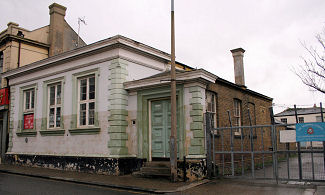
Preston Street Drill Hall - Preston
Street Elevation, 2007
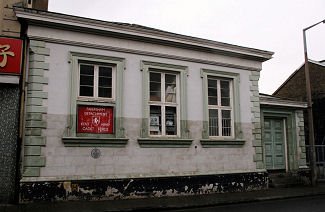
Preston Street Drill Hall - Preston
Street Elevation, 2007
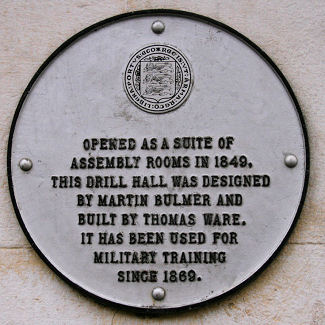
Plaque - Preston Street Drill Hall

Interior, Preston Street Drill Hall,
circa 1980
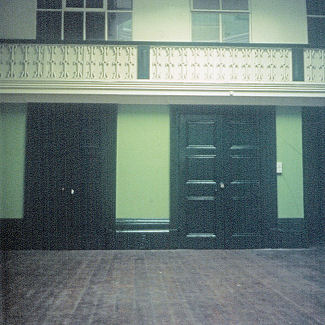
Interior, Preston Street Drill Hall,
circa 1980
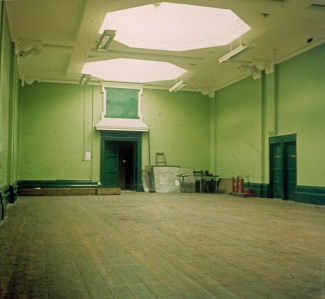
Interior, Preston Street Drill Hall,
circa 1980

Interior, Preston Street Drill Hall,
circa 1980
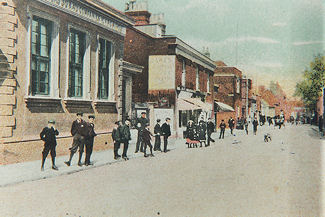
Postcard showing Preston Street Drill
Hall, circa 1905
Larger view of postcard
Larger view of postcard
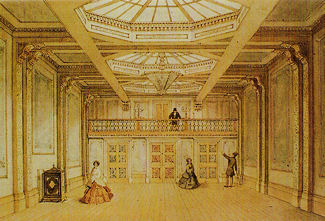
Postcard showing Preston Street Drill
Hall, circa 1905
Larger view of postcard
Larger view of postcard
© All material is copyright - refer to the
Terms of Use
the first attempt at content
Introduction
About
Anatomy
Drill
 Database
Database
 Memorabilia
Memorabilia
Resources Glossary
Saving Halls Participate Contact What's New? Terms of Use
Drill
 Database
Database Memorabilia
MemorabiliaResources Glossary
Saving Halls Participate Contact What's New? Terms of Use
The Drill Hall Project - Charting a neglected legacy